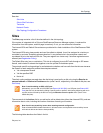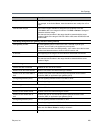
Site Topology
Polycom, Inc. 284
See also:
Site Links
Site-to-Site Exclusions
Territories
Network Clouds
Site Topology Configuration Procedures
Sites
The Sites page contains a list of the sites defined in the site topology.
If the system is integrated with a Polycom RealPresence Resource Manager system, it receives this
information from that system, and this page is read-only. If not, you can enter site information.
The Internet/VPN and Default Site entries are provided with a fresh installation of the RealPresence DMA
system.
The Internet/VPN entry always exists and can’t be edited or deleted. It can’t be assigned to a territory or
controlled by a cluster. Endpoints whose subnet isn’t in any defined site in the enterprise network are
considered to be in the Internet/VPN site. They can register to a cluster only if site-less registrations are
allowed (see Registration Policy).
The Default Site entry has no restrictions. This site is configured to route SIP calls through a SIP-aware
firewall, and includes 3 subnets that together cover the private IPv4 address space.
The protocol-specific routing settings for a site determine whether and how calls from that site can traverse
the firewall to reach endpoints outside the enterprise network:
● Via a transparent firewall
● Via the specified SBC
● Not at all
The site’s routing settings are used when the dial string is resolved by a dial rule using the Resolve to
external address or Resolve to IP address action (rules 5 and 6, respectively, of the default dial plan; see
Dial Rules).
The commands in the Actions list let you add a site, edit or delete sites (other than Internet/VPN), and see
information about a site, including the number of devices of each type it contains.
The following table describes the fields in the list.
Note: Consider adding an SBC or SIP peer
Alternatively, you can add an H.323 SBC (see External H.323 SBC) or a SIP peer (see External SIP
Peer) that can only be reached by dialing a specific prefix or prefixes. A dial string beginning with such
a prefix can be resolved by the dial rule using the Resolve to service prefix action (rule 4 of the
default dial plan).
Note: Avoid case-sensitivity issues when entering network configuration
Enter all network/DNS-related information in all lower case to avoid possible case-sensitivity issues
with various devices and ensure interoperability.


















